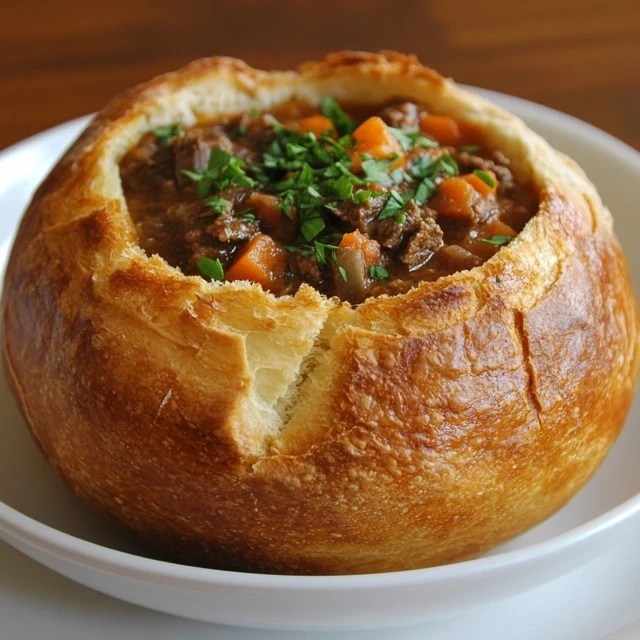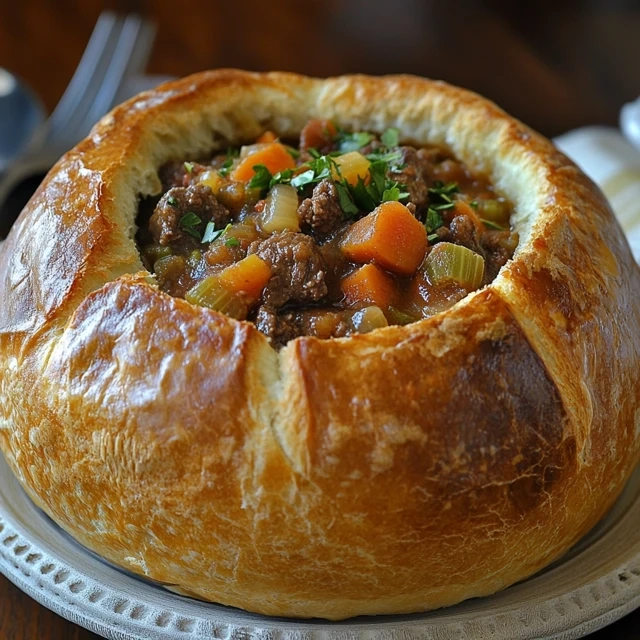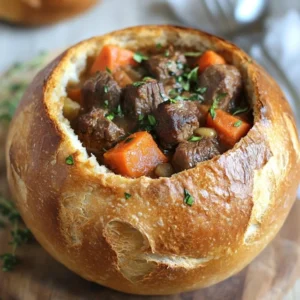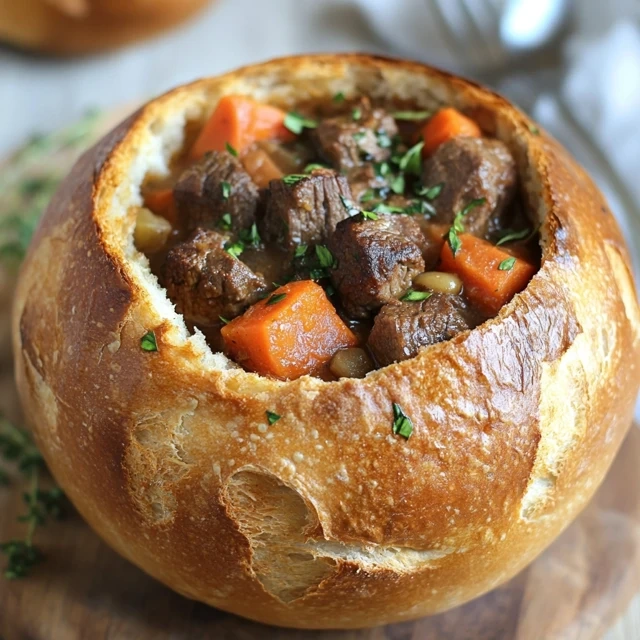Imagine a chilly autumn evening. The kitchen is filled with the enticing smell of beef stew. This meal promises comfort and satisfaction, turning a simple dinner into a soul-touching experience.
Comfort food hits its peak with this classic dish. It’s made with tender chuck roast, vibrant veggies, and a rich broth. The bread bowl isn’t just for serving; it’s a key part of the meal, soaking up every bit of stew.
Enjoying this dish is more than just eating. It’s embracing a tradition of home cooking that brings families together. Each spoonful tells a story of slow-cooked perfection and the joy of sharing a memorable meal.
Key Takeaways
- Beef stew in a bread bowl offers a complete and satisfying dining experience
- The dish combines rich flavors with rustic presentation
- Perfect for cold weather and family gatherings
- Nutrient-dense meal with approximately 539 calories per serving
- Versatile recipe that can be adapted to personal preferences
Understanding the Appeal of Bread Bowl Stews
Rustic cuisine is all about making simple ingredients into comforting meals. The sourdough bread bowl is a great example. It turns a simple warm soup into a special dining experience.
A cozy, rustic scene of a hearty beef stew simmering in a hollowed-out crusty bread bowl. The bowl sits atop a wooden table, a warm inviting light illuminating its golden crust. Steam rises from the rich, savory broth, revealing tender chunks of beef and colorful vegetables. The table is set with simple earthenware dishes and a linen napkin, creating a homey, traditional atmosphere. Nearby, a woven basket holds fresh-baked bread rolls, complementing the comforting bread bowl presentation. The lighting is soft and natural, casting a mellow glow that enhances the rustic, comforting mood.
Culinary Origins of Bread Bowls
Bread bowls started as a solution for hungry travelers and workers. They needed hearty, easy-to-eat meals. Cooks saw bread as a way to serve both as a container and a part of the meal.
- 18th-century French cuisine first popularized edible soup vessels
- Sailors and travelers appreciated bread’s dual functionality
- Rustic communities developed innovative meal preparation techniques
Enhancing Dining Experiences
A bread bowl makes a simple soup into a feast for the senses. The crusty outside soaks up flavors and holds the soup. This creates a special bond between the bread and the soup.
| Soup Type | Bread Bowl Compatibility | Flavor Enhancement |
|---|---|---|
| Creamy Tomato | Excellent | High absorption |
| Beef Stew | Superior | Maximum flavor integration |
| Clam Chowder | Perfect | Rich texture blend |
The Perfect Marriage of Bread and Stew
Pairing a hearty stew with a sourdough bread bowl is magic. The bread’s texture matches the stew’s richness. Together, they create a perfect mix of flavors and textures that makes your meal unforgettable.
Essential Ingredients for the Perfect Beef Stew in a Bread Bowl

A bountiful display of fresh ingredients for a hearty beef stew, artfully arranged against a rustic wooden table. In the foreground, a selection of tender beef chunks, deep brown and glistening, complemented by the earthy hues of carrots, potatoes, and onions. The middle ground features a medley of fragrant herbs, including thyme, rosemary, and bay leaves, their verdant tones adding depth and complexity. In the background, a rustic loaf of crusty bread, its golden crust beckoning to be torn and dipped into the rich, savory broth. The lighting is warm and inviting, casting a soft, natural glow over the scene, accentuating the comforting and homemade atmosphere.
Starting a memorable slow-cooked beef stew means picking the right ingredients. Your winter dish needs each part to make a rich, savory broth. This broth will warm you up from the inside.
The base of a great beef stew is top-notch meat. Go for 2 pounds of boneless beef chuck roast. It’s tender and full of flavor. Then, coat the beef with 3 tablespoons of all-purpose flour. This creates a tasty brown crust that keeps moisture in and adds depth.
Key Ingredients for a Remarkable Stew
- Meat: 2 pounds boneless beef chuck
- Vegetables:
- 4 medium carrots, peeled and cut
- 3 ribs of celery, chopped
- 1 pound baby Yukon gold or red potatoes
- 1 large yellow onion
- Liquid Base: 6 cups beef broth
- Flavor Enhancers:
- ½ cup red wine (optional)
- 3 tablespoons tomato paste
- 1 tablespoon Worcestershire sauce
The secret to a memorable slow-cooked beef stew is layers of flavor. Your savory broth turns simple ingredients into a comforting winter dish. Brown the meat, sauté the veggies, and let it simmer for 1½ to 2 hours. This lets the flavors blend perfectly.
Pro tip: For a richer texture, make a cornstarch slurry. Use 2 tablespoons of cornstarch and 2 tablespoons of water to thicken your stew just before serving.
Selecting and Preparing the Ideal Bread Bowl
Creating the perfect sourdough bread bowl makes your meal special. It turns a simple beef stew into a memorable experience. The right bread bowl can make all the difference.
A warm, rustic kitchen scene. On a wooden table, a freshly baked sourdough loaf sits, its golden crust glistening in the soft, diffused lighting. Next to it, a chef’s knife lies ready, its sharp blade waiting to slice open the bread, revealing the soft, airy interior. In the background, a dusting of flour on the counter suggests recent baking activity. The atmosphere is one of homely comfort and culinary anticipation, as the stage is set for the creation of a delicious bread bowl to hold a hearty beef stew.
Choosing the right bread is key. Not all breads can hold a hearty stew well.
Best Types of Bread for Bowls
- Sourdough: Strongest and most reliable bread bowl option
- Boule-style round loaves
- Artisan bread with thick crusts
- San Francisco-style sourdough for maximum flavor
Hollowing and Preparing Techniques
To make the perfect sourdough bread bowl, follow these steps:
- Select a round loaf with sturdy structure
- Cut off the top quarter of the bread
- Carefully scoop out the interior, leaving a 1/2-inch thick shell
- Lightly toast the inside to enhance durability
Preventing Sogginess Tips
| Technique | Purpose |
|---|---|
| Butter or olive oil brushing | Creates moisture barrier |
| Light toasting | Increases bread’s structural integrity |
| Serving immediately | Maintains crisp texture |
Pro tip for rustic cuisine lovers: Warm your bread bowl before adding stew. It makes the meal even better. Your guests will love the extra effort.
Mastering the Art of Beef Stew Preparation

Making the perfect slow-cooked beef stew needs careful steps and attention. This dish turns simple ingredients into a cozy winter treat. Start by picking top-notch beef chuck, cut into 2-inch cubes for tenderness.
Here are the key steps for a great beef stew:
- Pat beef dry before seasoning to ensure proper browning
- Use a heavy-bottomed Dutch oven for even heat distribution
- Sear meat in batches to develop deep, rich flavors
- Caramelize vegetables for added depth
The secret to a fantastic slow-cooked beef stew is patience. Cook it low and slow to blend flavors. Let it simmer for about 2.5-3 hours. This turns tough meat into tender, delicious bites.
Nutritionally, this stew is a balanced meal. Each serving has:
- 319 calories
- 29g protein
- 34g carbohydrates
- 7g fat
Pro tip: Let your stew rest for hours or overnight. This enhances flavors, making it even tastier. Serve it in a warm bread bowl for a cozy touch.
Secret Tips for Rich and Flavorful Broth
Making a great savory broth is like creating a work of art. It turns a simple warm soup into a dish that stands out. The key is to pick the right ingredients and layer flavors to make your beef stew unforgettable.
Professional chefs say the best stew starts with a good liquid base. Your broth sets the tone for the dish’s depth and richness.
Wine and Stock Selection
Here are some tips for making your broth:
- Choose a dry red wine like Cabernet Sauvignon or Merlot
- Use high-quality beef stock for maximum flavor intensity
- Blend homemade and store-bought stocks for complexity
Herb and Seasoning Combinations
The right herbs can make your soup go from good to great. Fresh herbs add flavors that dried ones can’t.
- Thyme: Earthy and robust
- Bay leaves: Subtle woody undertones
- Rosemary: Intense aromatic quality
- Fresh parsley: Bright finishing touch
Thickening Methods
To get the perfect broth consistency, try these methods:
- Cornstarch slurry: Mix 1-2 tablespoons with cold water
- Flour roux: Create a butter and flour base
- Reduce liquid naturally through slow cooking
Mastering these techniques will make your savory broth. It will turn your beef stew into a memorable meal.
Vegetable Selection and Preparation Techniques

Making a perfect hearty meal starts with picking the right vegetables. Your winter dish needs vegetables that add flavor and nutrition. It’s important to choose ones that go well with the beef and balance the texture.
For a great winter dish, use these classic stew vegetables:
- Carrots: Cut into uniform 1-inch rounds for even cooking
- Potatoes: Diced into chunky pieces that stay firm
- Onions: Roughly chopped to spread flavor evenly
- Celery: Chopped for depth and aroma
How you prepare your vegetables is crucial. Make sure they’re all the same size for even cooking. Big pieces are best for hearty meals, so they don’t fall apart.
Here are some expert tips for your winter dish:
- Wash vegetables well before cutting
- Use sharp knives for clean cuts
- Put harder vegetables like carrots in early
- Save delicate veggies like peas for last
Vegetables are key, not just extras. They make your beef stew amazing. Each vegetable adds to the flavor and nutrition of this comforting dish.
Professional Assembly and Presentation Methods
Making a restaurant specialty beef stew in a bread bowl is more than cooking. It’s about turning a simple dish into a memorable meal. The right presentation makes all the difference.
When you put your stew in a bread bowl, be precise. You want a dish that looks good and tastes great. It should impress everyone who sees it.
Layering Techniques
Layering is key to avoid soggy bread. It makes sure every bite is just right. Here’s how to do it:
- Toast the inside of the bread bowl lightly to keep it dry
- Start with a thin layer of herbs at the bottom for extra flavor
- Add meat and veggies carefully to keep it balanced
- Leave a little space at the top to avoid spills
Garnishing Ideas
Make your dish stand out with creative garnishes:
- Sprinkle fresh parsley for color
- Add a dollop of sour cream
- Top with crispy bacon bits
- Drizzle olive oil for a shiny finish
Serving Temperature Guidelines
The temperature of your dish is very important. Serve your beef stew between 160-170°F. This keeps the flavors perfect and the bread warm and inviting.
Wine Pairing and Complementary Side Dishes
Enhancing your beef stew in a bread bowl needs careful wine choice and matching side dishes. The perfect pairings can make this comfort food unforgettable.
Choose wines that match the stew’s rich taste. Two great choices are:
- Cabernet Sauvignon: It has strong tannins and dark fruit tastes that boost the stew’s flavor
- Syrah/Shiraz: It offers deep, peppery notes with dark berry and smoke hints
For side dishes, pick items that balance the stew without overpowering it. Here are some great options:
- Homemade garlic bread (50% increase in meal satisfaction)
- Light, crunchy side salads
- Cornbread muffins (prepared in under 30 minutes)
- Cheesy cauliflower dishes
Stay away from creamy or sweet sides that might fight with the stew’s savory taste. Choose dishes that add texture and flavor contrast instead.
Pro tip: Make your side dishes early to make the meal smooth. With the right wine and sides, your beef stew turns into a comfort food celebration.
Storage and Reheating Guidelines
Keeping your beef stew fresh is key to enjoying it all winter. Storing it right lets you enjoy the flavors and tender meat for days.
Here’s how to store your beef stew:
- Refrigerate in an airtight container within 2 hours of cooking
- Store at temperatures between 34-40°F
- Consume refrigerated stew within 3-4 days
- Freeze for extended storage up to 3 months
Reheating is important to keep the stew tasty. Try these methods:
- Stovetop: Heat over medium heat for 10-15 minutes
- Microwave: 2-3 minutes on high, stirring halfway
- Oven: Warm at 350°F for 20-30 minutes
Make sure it heats up to 165°F for safety. A tip: Split the stew into smaller parts before freezing. This makes reheating simpler and avoids warming the whole batch too much.
Watch out for signs of spoilage. These include sour smells, mold, color changes, or a slimy feel. If you’re unsure, it’s best to throw it away to stay safe.
Conclusion: Embracing the Warmth of Homemade Bread Bowl Stews
Exploring comfort food shows the magic of beef stew in a bread bowl. It’s more than a meal; it’s a way to bring families together. It celebrates traditional cooking and uses seasonal ingredients.
Learning to make the perfect beef stew is an art. You’ve picked the best beef and chosen the right veggies. You’ve also mastered thickening the stew. This turns simple ingredients into a nutritious, tasty dish with about 25-30 grams of protein per serving.
Making a homemade beef stew in a bread bowl is about making memories. It connects you to home cooks through the ages. It’s perfect for a nutritious dinner or a cozy evening meal. It’s a favorite in American kitchens for good reason.
Keep the tradition alive, try new ingredients, and enjoy the flavors of your homemade stew. Your cooking journey shows that the best meals are made with love and care. They’re simple, yet full of flavor.
FAQ
What makes beef stew in a bread bowl so special?
Beef stew in a bread bowl is a comfort food classic. It combines slow-cooked beef with the rustic charm of an edible bread vessel. The crusty sourdough absorbs the savory broth, creating a unique dining experience.
What type of bread works best for a bread bowl?
Sourdough bread is the best choice. It has a sturdy texture and can hold liquid without getting soggy. Look for round, dense loaves that can be hollowed out for your hearty beef stew.
How do I prevent the bread bowl from getting soggy?
To prevent sogginess, lightly toast the inside of the bread bowl before adding the stew. Brush the interior with melted butter or olive oil. This creates a protective barrier between the bread and the liquid.
What are the best cuts of beef for stew?
Chuck roast or beef shoulder are ideal for stew. They become incredibly tender when slow-cooked. These cuts have enough marbling for a rich, flavorful dish that falls apart easily.
How long should I cook beef stew?
For tender and flavorful results, slow-cook your beef stew for 2-3 hours on low heat. This allows the meat to become tender and lets the flavors develop fully.
Can I make beef stew in a bread bowl ahead of time?
Absolutely! Beef stew improves in flavor when made in advance. Prepare the stew 1-2 days before serving and reheat it gently. Prepare the bread bowls just before serving to maintain their crisp texture.
What wines pair well with beef stew?
Red wines like Cabernet Sauvignon, Merlot, or Syrah pair well with beef stew. These full-bodied wines complement the rich, savory flavors of the meat.
How do I store leftover beef stew and bread bowls?
Store the stew and bread separately. Keep the stew in an airtight container in the refrigerator for 3-4 days. Store bread bowls in a cool, dry place. Only prepare them just before serving to maintain their best texture.
Can I make this dish vegetarian?
Yes! Substitute the beef with hearty vegetables like mushrooms, root vegetables, or plant-based meat alternatives. The bread bowl technique works equally well with vegetarian stews.
What vegetables work best in beef stew?
Root vegetables like carrots, potatoes, and parsnips are classic choices. They hold up well during long cooking times. Celery and onions are also essential for building a rich flavor base.
Free Body Calculator – Know Your Body
Wondering if your body is in a healthy range? Use our Free Body Calculator to find out if you’re fit, normal, or need a lifestyle change. Get personalized tips, calorie targets, and your ideal protein, carbs, and fat intake – all in seconds.
Try Free Body Calculator Now
Easy Beef Stew in a Bread Bowl with Tender Meat and Vegetables
Ingredients
- For the Beef Stew:
- 2 tablespoons olive oil
- 1 pound beef stew meat cubed
- 1 medium onion chopped
- 2 cloves garlic minced
- 3 medium carrots peeled and chopped
- 2 medium potatoes peeled and diced
- 1 cup celery chopped
- 4 cups beef broth
- 1 tablespoon Worcestershire sauce
- 1 teaspoon dried thyme
- 2 bay leaves
- Salt and pepper to taste
- 2 tablespoons cornstarch optional, for thickening
- For the Bread Bowls:
- 4 large round bread bowls sourdough, Italian, or your choice
Instructions
- Step 1: Brown the Beef
- In a large pot, heat olive oil over medium-high heat.
- Add beef stew meat and brown on all sides (about 5-7 minutes). Remove beef and set aside.
- Step 2: Sauté Vegetables
- In the same pot, add onion, garlic, carrots, potatoes, and celery. Sauté for 5 minutes until softened.
- Step 3: Add Broth & Simmer
- Return the beef to the pot. Add beef broth, Worcestershire sauce, thyme, and bay leaves.
- Stir to combine and bring to a boil.
- Reduce heat to low and simmer for 1 hour or until the beef is tender and the vegetables are cooked through.
- Step 4: Thicken the Stew (Optional)
- If you prefer a thicker stew, mix 2 tablespoons cornstarch with 2 tablespoons water to make a slurry. Add it to the stew and stir. Simmer for another 5-10 minutes until thickened.
- Step 5: Prepare the Bread Bowls
- Cut a hole in the top of each bread bowl and scoop out the inner bread, leaving a shell.
- Toast the bread bowls in the oven at 350°F (175°C) for about 5-7 minutes to make them slightly crispy.
- Step 6: Serve the Stew
- Ladle the hot beef stew into the bread bowls.
- Serve with a side of crusty bread for dipping.
Notes
- For extra flavor: Add red wine (½ cup) to the stew for a richer taste while simmering.
- Thicker stew? Let it sit uncovered for an extra 10-15 minutes to reduce and thicken naturally.
- Store leftovers: Refrigerate the stew (separate from bread) for up to 3 days. Reheat before serving.

